Vin Santo del Chianti DOC
Vendemmia 2020
Anche quest'anno alla Fattoria di Selvapiana abbiamo concluso con soddisfazione la raccolta dei frutti delle nostre vigne. In questa galleria di foto vi raccontiamo una storia che si tramanda da generazioni e che si rinnova ogni anno
Bryce Wiatrak presenta Selvapiana nel suo articolo sul Vin Santo per Vinous Media
Bryce Wiatrak presenta Selvapiana nel suo articolo sul Vin Santo per Vinous Media. Selvapiana The furthest north I traveled in my exploration of Vin Santo was to Chianti Rùfina to visit Federico Giuntini at Selvapiana. I can hardly characterize an entire sub-region based solely on one producer, nonetheless for a wine as unpredictable as Vin Santo. But, Selvapiana’s Vin Santos show more finesse and less body than their more southerly relatives (including those of Giuntini’s cousin Roberto Stucchi Prinetti at Badia a Coltibuono), similar to how one might generally compare Chianti Rùfina with Chianti Classico. After harvest around the end of September, Giuntini hangs the grapes from bamboo rods to dry for five months. The wine spends six years in caratelli, made mostly from either French or Slavonian oak, but a few chestnut barrels remain. Giuntini misses the cherry caratelli, and would love to bring some back into the program. I had the distinct pleasure of tasting through ten vintages of Selvapiana’s Vin Santodel Chianti Rùfina. Giuntini tracked down bottles dating back to 1958 for this tasting. One quality that binds Selvapiana’s Vin Santos is a crystalline purity of flavor, unmatched by any of the other producers I visited. One hundred-percent Trebbiano, these are wines driven by acidity, untethered from their viscosity. In many respects, this is a more subdued variant of Vin Santo, more slender than many of its relatives. Beginning with the 2007, you immediately enjoy an orange juiciness that runs through the wine. It flashes all the other more savory notes associated with Vin Santo– garden herbs, buttered popcorn – but it’s never bogged down by them. It shows a rewarding viscidity without carrying a heaviness of flavor. The 2006 and 2003 are where Selvapiana’s Vin Santos really hit their stride. This extra time in bottle composes the wine into a Mozartian precision. Every note in these Vin Santos finds its way into a perfect contrapuntal balance. The 2006 demonstrates an iridescent, cold minerality that grows broad through a medley of fresh white peaches, nectarine and apricot. The 2003, too low in alcohol to achieve DOC recognition, boasts an even more expressive nose and unfolds slowly on palate. The acidity is so laser-like and long, it seems to finish far after the rest of the wine. Moving to the 2001, the Vin Santo at this age starts to imbue a more medicinal character – rosemary, quinine, sage. The fruit takes a backseat to these more earthly flavors. Federico explains that 2001 was a hotter vintage and he replaced many caratelli that year, which combined could account for the dramatic difference between this and the 2003. The 1999 treads a similar path as the 2001, the herbaceousness contributing a slight astringency. By 1998 we find a much darker Vin Santo, both in its hue and flavor profile. Notes of beeswax and bittersweet chocolate collide with the taste of wild mushrooms and ash. The 1997 seems to be aging at a tad slower pace. It’s a few shades brighter – caffè latte, rather than straight-up espresso. The 1993 shows darker still. Oxidation takes its toll on the Vin Santo, condensing the wine into a mass of burnt cashew, coffee grounds and cocoa beans. The astringency is undeniable, but it’s not an altogether unpleasant one. If anything, it’s an intellectually engaging experience tasting these lighter-bodied Vin Santos at this stage in their development, as was also the case with San Giusto a Rentenanno. While more unctuous renditions may never achieve the clarity of expression that defines these two producers’ Vin Santos, they nevertheless seem to outlive them, protected by that extra layer of insulation. Clusters hanging in the appassitoio at Selvapiana The last two Vin Santos in the flight, 1985 and 1958, are both in the winter of their lives, but reveal a fascinating window into the narrative of this product. Both vintages long before the creation of Vin Santo del Chianti DOC, these wines are labeled vino da tavola. The 1985 really embodies an amontillado character – saline and rich, like a perfect beef consommé. While the wine ends with a bitterness instead of that thrilling acidity, the butter flavors start to dance with more vitality than any of its younger brethren. The 1958 has lost much of its body by this age, whittled down to a salty skeleton. Much like its bottle, the wine shows a certain patina and tastes sprinkled with sawdust, the imbibable equivalent of walking into a cluttered antique shop, the dusty air illuminated by scattered rays of golden light. Federico defines these two wines as the old-style of Vin Santo, meant for the immediate consumption of friends rather than extended time in a collector’s cellar. So, they may not prove fully indicative of what will come of the more recent releases. What a treat it is, though, to taste history like this. Leggi l'articolo originale: http://www.antoniogalloni.com/articles/tuscany-s-mysterious-self-making-vin-santo-mar-2016



